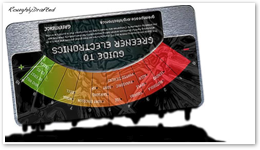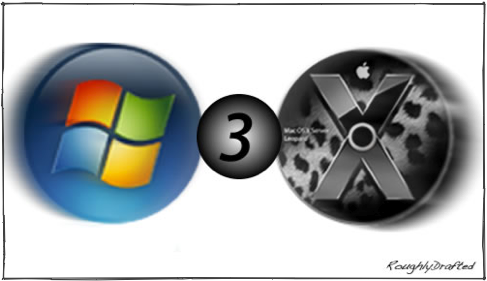
Leopard vs Vista 3: A Risk Strategy
It's tricky to directly compare Apple's Mac OS X Leopard and Microsoft's Vista, because the two products will be sold to very different markets in different ways. Here's a look at how both differ in strategic market positioning.
A RISK Strategy
PC enthusiasts like to scoff at the market share of Macs in comparison to worldwide computer sales. They view the worldwide PC market like a simple board game of Risk, where market leaders Dell and HP have more armies scattered over more territories, and Apple only has armies placed in a few. 

The strategic positioning of Apple compared to other PC makers figures into the comparison of Leopard and Vista because of The Indirect Choice: the market won’t be picking an operating system, but rather a hardware maker. PCs from Apple can run both, while PCs from everyone else will only run Windows.
Defending Gains
While Apple could focus its efforts on capturing wide swaths of the game board, the company's strategy so far has been to identify the best territories to hold, and defend them from being taken.
This strategy is familiar to anyone who's played Risk, and knows how easy it is to thinly spread armies all over the board game, only to subsequently lose them all to other players.
 Similarly, rather than spreading itself thin by shipping high volume, low profit boxes to inflate its market share numbers, Apple only sells premium PCs it can earn a sustainable profit on, and specifically targets customers who benefit most from the company’s tightly integrated product line.
Similarly, rather than spreading itself thin by shipping high volume, low profit boxes to inflate its market share numbers, Apple only sells premium PCs it can earn a sustainable profit on, and specifically targets customers who benefit most from the company’s tightly integrated product line.Not only are Macs eating up the most valuable segments of the PC market, but they are tenaciously holding on to growth in ways commodity PC makers can't. Without anything to differentiate PCs, there is no reason for a Dell customer to buy from Dell again if an equivalent, cheaper box is available from HP.
Dell’s Slipping Market Share
That’s exactly what’s happening to Dell now, as HP pushes prices lower. After a decade and a half of impressive growth, Dell's worldwide lead in the PC market has slipped away. Gartner reports that in the last quarter, Dell lost 7.1% of its previous US sales compared to a 23% advance by HP and 31% growth by Apple.
While HP and Dell’s market share can grow and shrink dramatically based on pricing fluctuations and the outcome of few big deals, Apple offers its customers a unique product with no direct equivalent in the market, making it harder for PC makers to poach Apple’s sales.
Why Apple Bounced Back described how Apple's growing portfolio of Mac-only software applications has helped to not only fuel growth, but also retain newly captured territory.
In other words: once you go Mac, you don't go back.
Microsoft and Market Share
Microsoft has been insulated from PC hardware market dynamics as long as it's been in business; the company doesn't care if its HP or Dell paying it for Windows, so long as it’s 95% or more of the market.
With Apple however, Microsoft faces a threat of lost sales that it can not easily regain. Remember that Microsoft didn't take market share away from Apple, as historical revisionists like to claim, but instead built the PC industry outside of Apple’s core markets.
Individual Mac users may have moved to Windows PCs, but Apple's Mac sales never appreciably dropped. It was Apple's growth against the rest of the PC industry that stalled. 

Microsoft didn't build its Windows empire by wooing Mac users to PCs, but rather migrated the rest of the world from calculators, workstations, and mainframe terminals to PCs running Windows.
Apple at Bat
Now that Apple is a PC vendor with growth exceeding the PC industry at large, it is in a position to convert Windows users to the Mac. For the first time ever, Mac users can run Windows natively if they choose, so there’s no remaining risk or barrier to switching to the Mac.
Apple is by far at its strongest competitive position in more than a decade, right as Microsoft is at its weakest, struggling to cope with legacy problems, architectural flaws, and security issues, and hoping to sell its user base on a long overdue and expensive upgrade to the new and unproven Vista.
Microsoft’s Crumbling Monopoly
Microsoft’s monopolistic control over the PC operating system market faces stiff competition from two very different fronts:
-
•Linux and other free and open source alternatives are attacking Microsoft's business in server and mass deployment markets represented by governments, the Enterprise and emerging foreign markets, while
-
•Apple and its ‘premium PC’ Macs are threatening some of the most valuable commercial market segments: graphic design, sci-tech, film and music production, and boutique consumers drawn to Apple's retail stores.
Microsoft's OEM bundling agreements have long served as the main barrier that prevented competition in the market for PC operating systems and allowed the company to maintain its monopoly. 

This Windows Price Paradox still works to prevent the adoption of Linux, and is a major reason why Apple can't realistically offer Leopard for sale as a retail box for PCs. However, the next article will examine how this anti-competitive technique will work to Microsoft's disadvantage in the choice between Leopard and Vista.
This Series










Friday, November 17, 2006

 Bookmark on Del.icio.us
Bookmark on Del.icio.us Discuss on Reddit
Discuss on Reddit Critically review on NewsTrust
Critically review on NewsTrust Forward to Friends
Forward to Friends
 Get RSS Feed
Get RSS Feed Download RSS Widget
Download RSS Widget





